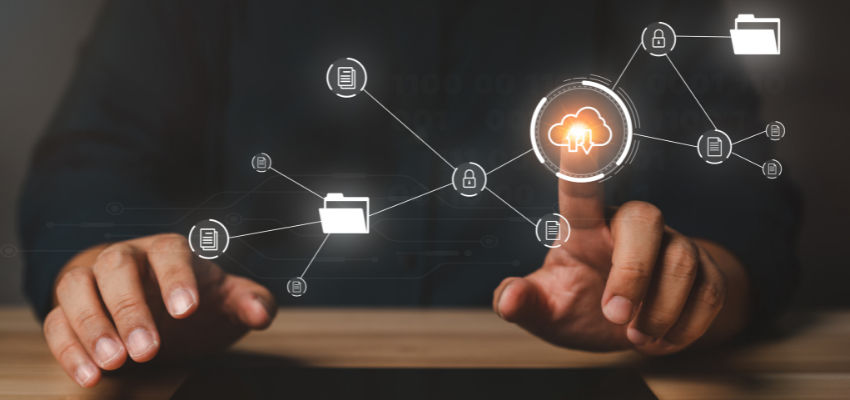Show:
Protecting Data Amidst the Transition to Digital Business
A digital transformation equals a security transformation. Data security is the top challenge for companies transitioning to digital business operations. As companies move to reap the benefits of digital transformation, they must move from legacy technology and analog business data while guaranteeing data security in the process. So, resolving these two issues can accelerate an enterprise’s transformation and bring a more rapid return on investment.

With security breaches and cybercrimes increasing, data is being stolen, monetized, and resold, causing extensive financial and reputational damage. Data security is no longer one of many company tasks but a strategic priority.
Why digital transformation is important
The COVID-19 pandemic accelerated the digital transformation due to the need to keep businesses running, even remotely. It also fueled incredible data production in terms of volume and speed. Now, digital transformation is front and center as companies move to improve efficiency, products, and customer service through innovation across organizations. Accenture.com reports that companies investing in technology now grow as much as five times faster, which is excellent motivation.
What does a digital transformation involve?
The objective of any digital transformation is to use technology to optimize business processes and procedures for increased efficiency, flexibility, and competitiveness. It involves leveraging business technology to improve a company’s performance and will affect every aspect of business operations, including marketing, sales, and customer service.
As massive amounts of data become available, digital transformations also involve a move to cloud technology for data storage and enhanced storage security. A digital transformation can involve the move to a single IT platform integrated with AI to simplify and automate company operations.
Each digital transformation will be unique. Individual company needs will vary and require a move away from management’s traditional thinking toward innovation and a potentially experimental approach to doing things. Digital management also offers scalability, which looks to the future, allowing for growth, mergers, or the integration of new information, diagnostic tools, and more. Nonetheless, with the increasing integration of IoT, the threat surface is in continual expansion.
Protecting data amidst a digital business transition
Business owners and executives must enable a secure digital transformation to protect company and customer interests. Here, we examine essential steps to keep sensitive data safe during the transformation process.
1. Make security part of the conversation
When programming technological innovations that modify business processes, company leaders must prioritize security, keeping it at the center of any discussion. Security IT experts need to be involved to highlight potential and emerging risks when applying a transformation strategy. The Ponemon’s Digital Transformation and Cyber Risk Report cites 82% of IT security respondents stating that at least one data breach occurred during their digital transformation. The risks have never been more significant with digital changes primarily focused on financial operations and data storage. Keeping security as an essential part of any digital transformation program can work to protect the transformation process from data theft and loss.

2. Integrate continuous risk assessments
With legacy technology, risk and threat assessments were often static and annual, if not occasional. Risk assessments can benefit from automation using AI and machine learning with the risk landscape in continual evolution at an increasingly fast pace. Accompanying a digital transformation with automated processes can afford greater recognition of anomalies that may open the door to data breaches.
3. Physical security
Although you are working on a digital transformation, this does not imply that physical security should be overlooked. Restricting physical access using technologies such as door intercom systems to stored data locations is essential to protecting the information as a part of your cybersecurity strategies. Determining where, when, and why certain employees can have access is vital to general security. Limiting who can access data to only those who need the data can result in better overall protection.
Physical and digital access control management should be a part of any security strategy. Employees should only be given the access they need. Data breaches can be the result of internal theft or simple human error. Unlimited access to an entire digital system should never be granted.
4. Manage access
The digital transformation brings increased use of computers, tablets, and smartphones. MFA or multi-factor authentication is one method for reducing risk while your company transitions to a digital business. MFA using two or more authentication methods will add protection of data. Incorporating affordable VPNs into remote access can further enhance security by encrypting data transmission.
A Zero Trust Architecture is another option, with many electronic devices connected to the internet using apps, chats, and platforms. Zero Trust requires every device and user to be authenticated at every login, regardless of who they are or their role in the company. This system access is one way to ensure who is accessing information is always authorized correctly.
5. Encryption
All data needs to be encrypted, whether stored or transiting. Encryption is critical if you move large amounts of data during a digital transition. If your data is intercepted, it cannot be accessed unless the criminal has the encryption key.
6. Don’t underestimate vendor risk
When switching to new digital technologies, it’s common for companies to rely on third-party vendors for furnishing and implementing new technologies. Vendor risk personnel should operate together with company IT security teams. Vendors must have security policies and practices that guarantee the security of their products and services. Internal company risk management must connect with third-party vendor risk management. In an increasingly digital world, company and vendor security IT teams are part of the same ecosystem.
7. Train employees and run testing
Regular training of employees concerning digital technologies can aid in preventing internal data leaks and external threats such as phishing or malware attacks. Companies must also conduct penetration testing regularly on new digital technologies and software to uncover vulnerabilities. Insider threats, whether due to simple human error or untrustworthy employees, need to be mitigated.
Conclusion
A digital transition allows businesses to drive innovation, change, and work for greater efficiency, flexibility, and value. However, the process and the use of new technologies bring a new generation of risks. Prioritizing security during every transition step will allow your company to protect sensitive and invaluable data.

 Return to Previous Page
Return to Previous Page








